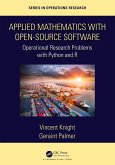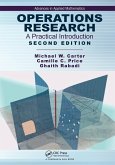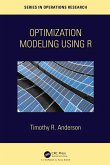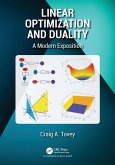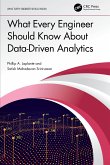Vincent Knight, Geraint Palmer
Applied Mathematics with Open-Source Software
Operational Research Problems with Python and R
Vincent Knight, Geraint Palmer
Applied Mathematics with Open-Source Software
Operational Research Problems with Python and R
- Gebundenes Buch
- Merkliste
- Auf die Merkliste
- Bewerten Bewerten
- Teilen
- Produkt teilen
- Produkterinnerung
- Produkterinnerung
This book is aimed at a broad segment of readers who wish to learn how to use open-source software to solve problems in applied mathematics.Each chapter starts with a problem, gives an overview of the relevant theory, shows a solution approach in R and in Python, and finally gives wider context by including a number of published references.
Andere Kunden interessierten sich auch für
![Applied Mathematics with Open-Source Software Applied Mathematics with Open-Source Software]() Vincent KnightApplied Mathematics with Open-Source Software64,99 €
Vincent KnightApplied Mathematics with Open-Source Software64,99 €![Operations Research Operations Research]() Michael CarterOperations Research49,99 €
Michael CarterOperations Research49,99 €![Optimization Modelling Using R Optimization Modelling Using R]() Timothy R. AndersonOptimization Modelling Using R95,99 €
Timothy R. AndersonOptimization Modelling Using R95,99 €![HBR Guide to Data Analytics Basics for Managers (HBR Guide Series) HBR Guide to Data Analytics Basics for Managers (HBR Guide Series)]() Harvard Business ReviewHBR Guide to Data Analytics Basics for Managers (HBR Guide Series)14,99 €
Harvard Business ReviewHBR Guide to Data Analytics Basics for Managers (HBR Guide Series)14,99 €![HBR Guide to Data Analytics Basics for Managers HBR Guide to Data Analytics Basics for Managers]() Harvard Business ReviewHBR Guide to Data Analytics Basics for Managers46,99 €
Harvard Business ReviewHBR Guide to Data Analytics Basics for Managers46,99 €![Linear Optimization and Duality Linear Optimization and Duality]() Craig A. Tovey (Georgia Institute of Technology, Atlanta, USA)Linear Optimization and Duality76,99 €
Craig A. Tovey (Georgia Institute of Technology, Atlanta, USA)Linear Optimization and Duality76,99 €![What Every Engineer Should Know About Data-Driven Analytics What Every Engineer Should Know About Data-Driven Analytics]() Satish Mahadevan Srinivasan (USA Penn State Great Valley)What Every Engineer Should Know About Data-Driven Analytics66,99 €
Satish Mahadevan Srinivasan (USA Penn State Great Valley)What Every Engineer Should Know About Data-Driven Analytics66,99 €-
-
-
This book is aimed at a broad segment of readers who wish to learn how to use open-source software to solve problems in applied mathematics.Each chapter starts with a problem, gives an overview of the relevant theory, shows a solution approach in R and in Python, and finally gives wider context by including a number of published references.
Produktdetails
- Produktdetails
- Chapman & Hall/CRC Series in Operations Research
- Verlag: Taylor & Francis Ltd
- Seitenzahl: 152
- Erscheinungstermin: 27. Mai 2022
- Englisch
- Abmessung: 254mm x 178mm x 11mm
- Gewicht: 456g
- ISBN-13: 9780367348687
- ISBN-10: 0367348683
- Artikelnr.: 63085820
- Herstellerkennzeichnung
- Libri GmbH
- Europaallee 1
- 36244 Bad Hersfeld
- gpsr@libri.de
- Chapman & Hall/CRC Series in Operations Research
- Verlag: Taylor & Francis Ltd
- Seitenzahl: 152
- Erscheinungstermin: 27. Mai 2022
- Englisch
- Abmessung: 254mm x 178mm x 11mm
- Gewicht: 456g
- ISBN-13: 9780367348687
- ISBN-10: 0367348683
- Artikelnr.: 63085820
- Herstellerkennzeichnung
- Libri GmbH
- Europaallee 1
- 36244 Bad Hersfeld
- gpsr@libri.de
Vince Knight is a Senior Lecturer at Cardiff University in the School of Mathematics. His research interests are in emergent behaviour, probabilistic modelling, applications in healthcare and pedagogy. He maintains a number of open-source research software projects, is a trustee of the UK Python association, is an editor for the Journal of Open-Source Software, was awarded the 2017 John Pinner award for contribution to the Python community and is a fellow of the Sustainable Software Institute. He regularly wins awards for his teaching in the School of Mathematics. He does not only speak at conferences around the world but continues to organise conferences to bring the power of open-source software to as many people as possible. Geraint Palmer is a Welsh Medium Lecturer at Cardiff University in the School of Mathematics. He is a member of the operational research group where his research interests are in simulation and probabilistic modelling, in particular applying these to model public services such as healthcare systems. He uses open-source software in all aspects of his research: he is a maintainer of Ciw, an open-source Python library for discrete event simulation, and won the OR Society's Doctoral Award in 2018. Geraint is also a fellow of the Software Sustainability Institute and has presented at a number of international conferences on the subject of best practice of scientific computing, and regularly teaches programming and runs coding workshops for people of all ages.
Section I. Getting Started. 1. Introduction. 1.1. Who is This Book For?
1.2. What do We Mean by Applied Mathematics? 1.3. What is Open-Source
Software. 1.4. How to Get the Most Out of this Book. 1.5. How Code is
Written in this Book. Section II. Probabilistic Modelling. 2. Markov
Chains. 2.1. Problem. 2.2. Theory. 2.3. Solving with Python. 2.4. Solving
with R. 2.5. Wider Context. 3.Discrete Event Simulation. 3.1. Problem. 3.2.
Theory. 3.3. Solving with Python. 3.4. Solving with R. 3.5. Wider Context.
Section III. Dynamical Systems. 4. Differential Equations. 4.1. Problem.
4.2. Theory. 4.3. Solving with Python. 4.4. Solving with R. 4.5. Wider
Context. Chapter 5. Systems Dynamics. 5.1. Problem. 5.2. Theory. 5.3.
Solving with Python. 5.4. Solving with R. 5.5. Wider Context. Section IV.
Emergent Behaviour. 6. Game Theory. 6.1. Problem. 6.2. Theory. 6.3. Solving
with Python. 6.4. Solving with R. 6.5. Wider Context. 7. Agent Based
Simulation. 7.1. Problem. 7.2. Theory. 7.3. Solving with Python. 7.4.
Solving with R. 7.5. Wider Context. Section V. Optimisation. 8. Linear
Programming. 8.1. Problem. 8.2. Theory. 8.3. Solving with Python. 8.4.
Solving with R. 8.5. Wider Context. 9. Heuristics. 9.1. Problem. 9.2.
Theory. 9.3. Solving with Python. 9.4. Solving with R. 9.5. Wider Context.
1.2. What do We Mean by Applied Mathematics? 1.3. What is Open-Source
Software. 1.4. How to Get the Most Out of this Book. 1.5. How Code is
Written in this Book. Section II. Probabilistic Modelling. 2. Markov
Chains. 2.1. Problem. 2.2. Theory. 2.3. Solving with Python. 2.4. Solving
with R. 2.5. Wider Context. 3.Discrete Event Simulation. 3.1. Problem. 3.2.
Theory. 3.3. Solving with Python. 3.4. Solving with R. 3.5. Wider Context.
Section III. Dynamical Systems. 4. Differential Equations. 4.1. Problem.
4.2. Theory. 4.3. Solving with Python. 4.4. Solving with R. 4.5. Wider
Context. Chapter 5. Systems Dynamics. 5.1. Problem. 5.2. Theory. 5.3.
Solving with Python. 5.4. Solving with R. 5.5. Wider Context. Section IV.
Emergent Behaviour. 6. Game Theory. 6.1. Problem. 6.2. Theory. 6.3. Solving
with Python. 6.4. Solving with R. 6.5. Wider Context. 7. Agent Based
Simulation. 7.1. Problem. 7.2. Theory. 7.3. Solving with Python. 7.4.
Solving with R. 7.5. Wider Context. Section V. Optimisation. 8. Linear
Programming. 8.1. Problem. 8.2. Theory. 8.3. Solving with Python. 8.4.
Solving with R. 8.5. Wider Context. 9. Heuristics. 9.1. Problem. 9.2.
Theory. 9.3. Solving with Python. 9.4. Solving with R. 9.5. Wider Context.
Section I. Getting Started. 1. Introduction. 1.1. Who is This Book For?
1.2. What do We Mean by Applied Mathematics? 1.3. What is Open-Source
Software. 1.4. How to Get the Most Out of this Book. 1.5. How Code is
Written in this Book. Section II. Probabilistic Modelling. 2. Markov
Chains. 2.1. Problem. 2.2. Theory. 2.3. Solving with Python. 2.4. Solving
with R. 2.5. Wider Context. 3.Discrete Event Simulation. 3.1. Problem. 3.2.
Theory. 3.3. Solving with Python. 3.4. Solving with R. 3.5. Wider Context.
Section III. Dynamical Systems. 4. Differential Equations. 4.1. Problem.
4.2. Theory. 4.3. Solving with Python. 4.4. Solving with R. 4.5. Wider
Context. Chapter 5. Systems Dynamics. 5.1. Problem. 5.2. Theory. 5.3.
Solving with Python. 5.4. Solving with R. 5.5. Wider Context. Section IV.
Emergent Behaviour. 6. Game Theory. 6.1. Problem. 6.2. Theory. 6.3. Solving
with Python. 6.4. Solving with R. 6.5. Wider Context. 7. Agent Based
Simulation. 7.1. Problem. 7.2. Theory. 7.3. Solving with Python. 7.4.
Solving with R. 7.5. Wider Context. Section V. Optimisation. 8. Linear
Programming. 8.1. Problem. 8.2. Theory. 8.3. Solving with Python. 8.4.
Solving with R. 8.5. Wider Context. 9. Heuristics. 9.1. Problem. 9.2.
Theory. 9.3. Solving with Python. 9.4. Solving with R. 9.5. Wider Context.
1.2. What do We Mean by Applied Mathematics? 1.3. What is Open-Source
Software. 1.4. How to Get the Most Out of this Book. 1.5. How Code is
Written in this Book. Section II. Probabilistic Modelling. 2. Markov
Chains. 2.1. Problem. 2.2. Theory. 2.3. Solving with Python. 2.4. Solving
with R. 2.5. Wider Context. 3.Discrete Event Simulation. 3.1. Problem. 3.2.
Theory. 3.3. Solving with Python. 3.4. Solving with R. 3.5. Wider Context.
Section III. Dynamical Systems. 4. Differential Equations. 4.1. Problem.
4.2. Theory. 4.3. Solving with Python. 4.4. Solving with R. 4.5. Wider
Context. Chapter 5. Systems Dynamics. 5.1. Problem. 5.2. Theory. 5.3.
Solving with Python. 5.4. Solving with R. 5.5. Wider Context. Section IV.
Emergent Behaviour. 6. Game Theory. 6.1. Problem. 6.2. Theory. 6.3. Solving
with Python. 6.4. Solving with R. 6.5. Wider Context. 7. Agent Based
Simulation. 7.1. Problem. 7.2. Theory. 7.3. Solving with Python. 7.4.
Solving with R. 7.5. Wider Context. Section V. Optimisation. 8. Linear
Programming. 8.1. Problem. 8.2. Theory. 8.3. Solving with Python. 8.4.
Solving with R. 8.5. Wider Context. 9. Heuristics. 9.1. Problem. 9.2.
Theory. 9.3. Solving with Python. 9.4. Solving with R. 9.5. Wider Context.


